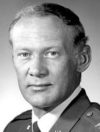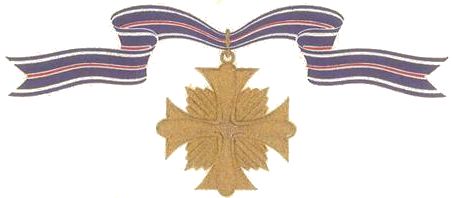Buzz Aldrin’s First Distinguished Flying Cross citation
THE UNITED STATES OF AMERICA
THIS IS TO CERTIFY THAT
THE PRESIDENT OF THE UNITED STATES OF AMERICA
AUTHORIZED BY ACT OF CONGRESS JULY 2, 1926 HAS
AWARDED
THE DISTINGUISHED FLYING CROSS
TO
EDWIN E. (BUZZ) ALDRIN, UNITED STATES AIR FORCE
FOR HEROISM
WHILE PARTICIPATING IN AERIAL FLIGHT
CITATION:
The President of the United States of America, authorized by Act of Congress, July 2, 1926, takes pleasure in presenting the Distinguished Flying Cross to First Lieutenant Edwin E. (Buzz) Aldrin, Jr., United States Air Force, for extraordinary achievement while participating in aerial flight on 14 May 1953 over North Korea, as Pilot of an F-86 type aircraft, 51st Fighter Interceptor Wing, FIFTH Air Force. Lieutenant Aldrin was flying number three position in a flight of six F-86s along the Yalu River. Lieutenant Aldrin observed a flight of two enemy MiG-15 through a hole in the clouds below. Simultaneously, with his calling out the MiGs, Lieutenant Aldrin dove to the attack, when within two thousand feet he fired one burst upon the wing of the MiG on the right. Realizing he was closing fast Lieutenant Aldrin withheld fire until he was within one thousand feet. Firing again he observed many good hits on the fuselage and the right wing. The MiG pulled up, smoking, into a thin spot in the overcast. Lieutenant Aldrin had to open his speed brakes to keep from overrunning the MiG. Firing again, pieces were seen to come off the MiG and a greater volume of smoke poured from the tail section. Lieutenant Aldrin continued to fire until the pilot ejected. Turning South, Lieutenant Aldrin and his wingman saw the MiG pilot’s parachute open. Because of his superior gunnery, airmanship and ability to take instant advantage of an opportunity, Lieutenant Aldrin has been credited with one MiG-15 destroyed. By this action, Lieutenant Aldrin has reflected great credit upon himself and the United States Air Force.
 Born: 20 January 1930 in Glen Ridge, N.J…. Graduated third in his class at the U.S. Military Academy (Class of ’51)… Earned two Distinguished Flying Crosses… Selected for NASA’s Astronaut Group 3 in 1963… Served as pilot aboard Gemini 12 and then lunar module pilot for Apollo 11, where he became the second man to walk on the moon… Retired as colonel in 1972
Born: 20 January 1930 in Glen Ridge, N.J…. Graduated third in his class at the U.S. Military Academy (Class of ’51)… Earned two Distinguished Flying Crosses… Selected for NASA’s Astronaut Group 3 in 1963… Served as pilot aboard Gemini 12 and then lunar module pilot for Apollo 11, where he became the second man to walk on the moon… Retired as colonel in 1972
